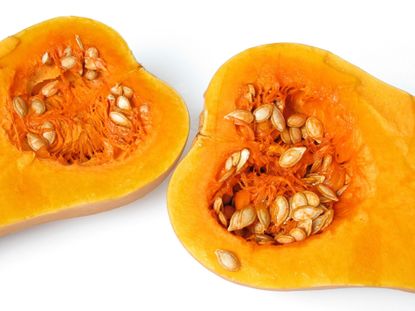Saving Squash Seeds: Learn About Squash Seed Harvesting & Storage


Have you ever grown a blue-ribbon Hubbard squash or another variety, but the next year the crop was less than stellar? Perhaps you have wondered if by collecting seeds from the prized squash, you might get another crop just as amazing. What is the best method then for squash seed collection and saving those premium squash seeds?
Squash Seed Harvesting
More and more often of late, plants and seeds available at the local home and garden center are comprised of hybrid varieties that have been engineered to retain selected characteristics. This hybridization, unfortunately, breeds out the plants' innate ability to adapt to inhospitable or challenging conditions. Luckily, there is a resurgence to save some of our heirloom fruit and vegetable varietals. Saving squash seeds for future propagation can be a bit of a challenge since some squash will cross pollinate, resulting in something less than appetizing. There are four families of squash, and the families don't cross pollinate, but members within the family will. Hence, it is necessary to recognize what family the squash belongs to and then only plant members of one of the remaining three nearby. Otherwise, you will have to hand pollinate squash to maintain a “true” squash for squash seed collection. The first of the four major families of squash is Cucurbit maxima which include:
Cucurbita mixta counts amongst its members:
- Crooknecks
- Cushaws
- Tennessee Sweet Potato squash
Butternut and Butterbush fall into the Cucurbita moshata family. Lastly, are all members of Cucurbita pepo and include:
Again, back to hybrid varieties, often the seed is sterile or doesn't reproduce true to the parent plant, so don't try squash seed harvesting from these plants. Don't attempt to save any seeds from plants that are afflicted with disease, as this will likely pass to the next year's generation. Select the healthiest, most bountiful, flavorful fruit to harvest seeds from. Harvest seeds for saving from mature fruit towards the end of the growing season.
Storing Squash Seeds
When seeds are ripe, they generally change color from white to cream or light brown, darkening to a dark brown. Since squash is a fleshy fruit, the seeds need to be separated from the pulp. Scoop the seed mass out of the fruit and place it in a bucket with a bit of water. Allow this mix to ferment for two to four days, which will kill off any viruses and separate the good seeds from the bad. Good seeds will sink to the bottom of the mix, while bad seeds and pulp float. After the fermentation period has completed, simply pour off the bad seeds and pulp. Spread the good seeds on a screen or paper towel to dry. Allow them to dry completely or they will mildew. Once the seeds are absolutely dry, store them in a glass jar or envelope. Clearly label the container with the variety of squash and the date. Place the container in the freezer for two days to kill off any residual pests and then store in a cool, dry area; the refrigerator is ideal. Be aware that seed viability decreases as time passes, so use the seed within three years.
Gardening tips, videos, info and more delivered right to your inbox!
Sign up for the Gardening Know How newsletter today and receive a free download of our most popular eBook "How to Grow Delicious Tomatoes."

Amy Grant has been gardening for 30 years and writing for 15. A professional chef and caterer, Amy's area of expertise is culinary gardening.
-
 Urban Composting Guide: How To Compost In The Middle Of The City
Urban Composting Guide: How To Compost In The Middle Of The CityUrban composting does not have to be daunting. You can compost in the city, and maybe even try some urban worm composting!
By Mary Ellen Ellis
-
 Shrub Diseases And Pests To Watch Out For
Shrub Diseases And Pests To Watch Out ForShrub diseases and pests can be challenging. Learn how to recognize and eradicate them before they can present a danger to your plants.
By Susan Albert